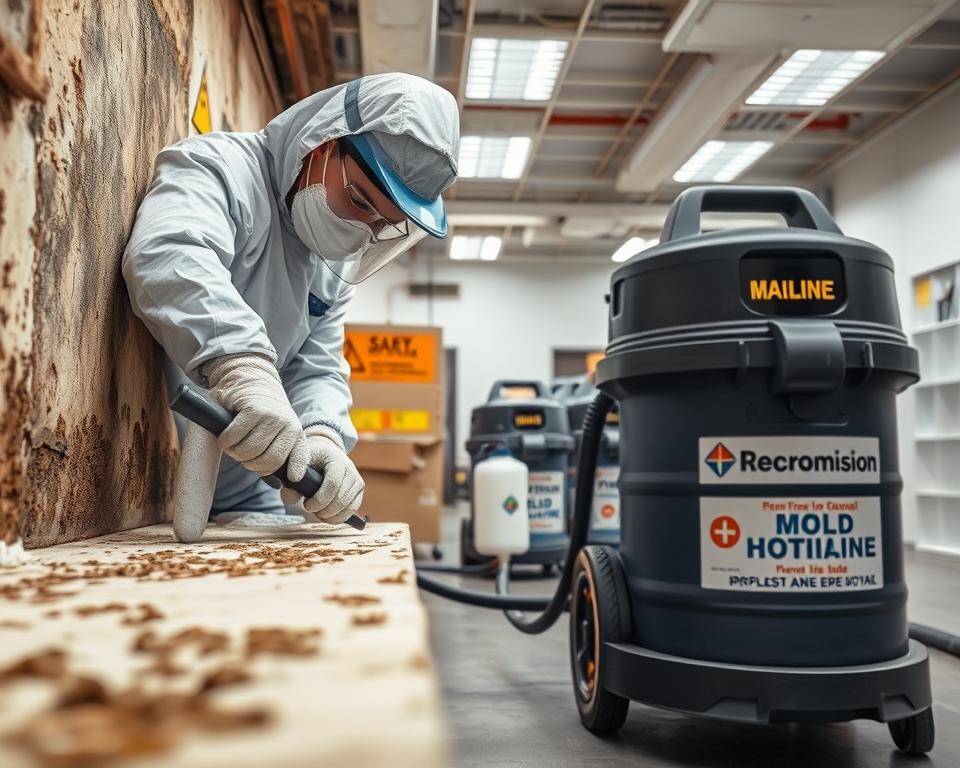Did you know 50% of homeowners who attempt DIY mold removal face recurring growth within six months? Hidden moisture and improper containment often undermine even the most thorough cleaning efforts. This startling reality underscores why specialized expertise matters when addressing fungal infestations.
Leading providers like SERVPRO and FDP Mold Remediation deploy industrial-grade solutions that go beyond surface cleaning. Their teams use infrared cameras to detect hidden dampness and negative air pressure systems to prevent spore spread. Unlike temporary fixes, these comprehensive approaches address root causes while protecting indoor air quality.
Costs for professional interventions vary based on affected areas. A small bathroom project might start at $500, while whole-home treatments can exceed $3,500. Transparent companies provide itemized estimates explaining equipment fees, labor costs, and post-remediation verification steps.
Key Takeaways
- Certified technicians follow IICRC standards for safe, lasting results
- Advanced moisture detection prevents future outbreaks
- HEPA filtration systems capture 99.97% of airborne particles
- Detailed contracts outline costs and containment strategies
- Third-party testing validates completion for insurance purposes
Understanding Mold Remediation Services
Many property owners underestimate fungal infestations until visible patches appear. Effective solutions require more than scrubbing surfaces—they demand strategic containment and moisture control.
What is Mold Remediation?
This systematic process tackles fungal colonies at their source. Specialists first identify moisture entry points using thermal imaging. They then isolate contaminated zones with plastic sheeting to prevent spore migration.
Industrial air scrubbers and HEPA vacuums remove microscopic particles. Antimicrobial treatments disinfect surfaces while addressing humidity issues. Unlike basic cleaning, this approach creates long-term protection against recurrence.
Importance of Certified Experts
Highly trained technicians follow strict safety protocols during removal. Their certifications ensure proper handling of toxic black mold and other hazardous varieties. They also document each step for insurance compliance.
| Aspect | DIY Approach | Professional Service |
|---|---|---|
| Containment | Plastic sheets | Negative air chambers |
| Equipment | Household cleaners | HEPA filtration systems |
| Safety | Basic masks | Respirators & protective gear |
Certified teams use moisture meters to detect hidden dampness. They also provide ventilation upgrades to inhibit future mold growth. This expertise minimizes health risks and structural damage.
Key Factors Influencing Mold Remediation Costs
Property restoration expenses vary widely based on multiple technical considerations. Three primary elements dictate service pricing: contamination scope, biological hazards present, and required containment strategies.
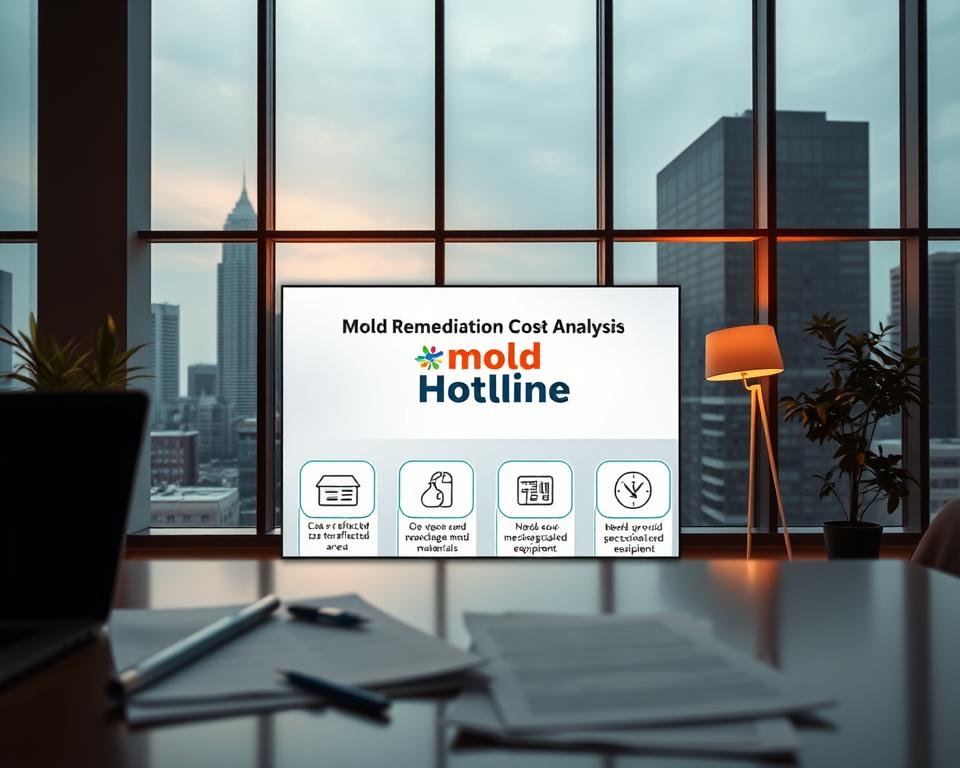
Impact of Affected Area Size and Infestation Extent
Contaminated square footage directly impacts labor hours and equipment needs. Small bathroom projects (under 50 sq. ft.) often cost $500-$1,500. Whole-home treatments exceeding 1,000 sq. ft. can surpass $6,000.
Infestation depth matters. Surface-level growth on tiles requires simple cleaning. Penetration into drywall or insulation demands demolition and reconstruction. Thermal imaging inspections ($300-$500) often reveal hidden moisture sources.
Types of Mold and Techniques Used
Black mold removal costs 20-50% more than common varieties due to strict containment protocols. Professionals use negative air pressure chambers and full-body protective gear for hazardous species.
| Project Type | Average Cost | Key Requirements |
|---|---|---|
| Surface Cleaning | $500-$1,200 | Antimicrobial sprays |
| Structural Remediation | $2,000-$7,000 | Material replacement |
Water damage repairs often add $1,000-$4,000 to total costs. Many companies bundle drainage improvements or dehumidifier installations to prevent recurrence. Urban locations typically charge 15-30% more than rural areas due to higher operational expenses.
Highest-Rated Mold Remediation Near Me: Our Premier Service Offering
Top-tier remediation firms transform chaotic fungal situations into controlled recovery projects. Companies like SERVPRO deploy truck-mounted extraction systems and infrared moisture detectors, tackling issues from attic colonies to basement outbreaks. Their 24/7 emergency teams arrive faster than standard contractors, a critical advantage when containing active spore spread.
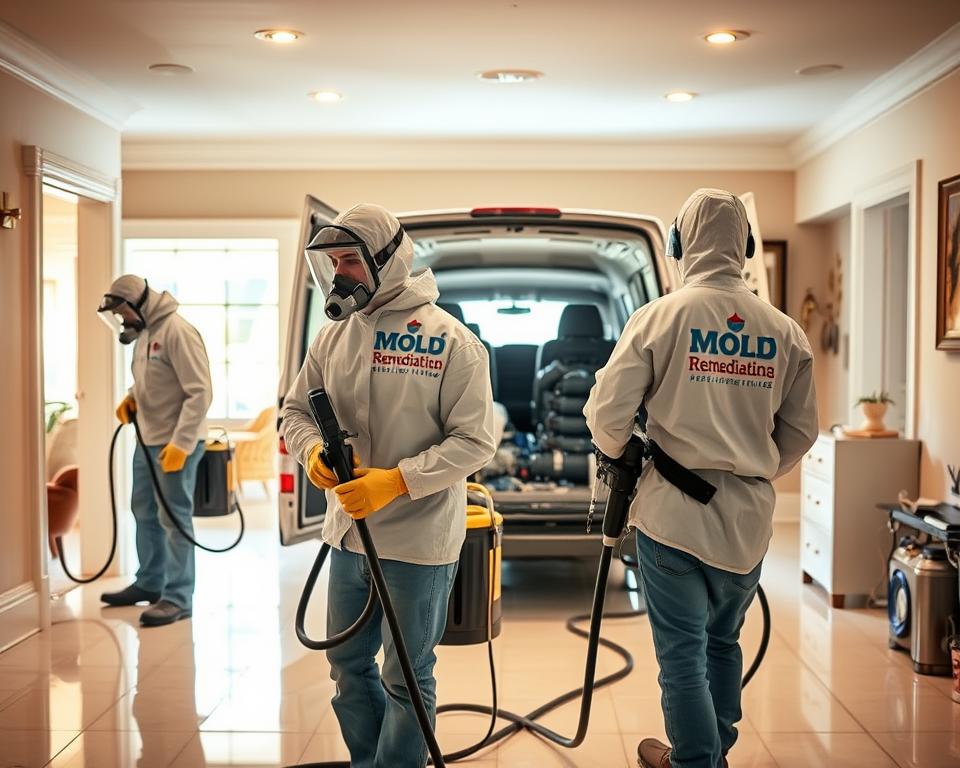
Leading services simplify insurance coordination through direct adjuster communication. They photograph damage zones, draft scope reports, and submit paperwork electronically—reducing claim processing times by 40-60%. MoldGone exemplifies this approach, combining family-operated oversight with IICRC-certified protocols.
Distinct advantages separate elite providers from general contractors:
- Multi-stage HEPA filtration removing 99.97% of airborne particulates
- Five-year warranties covering labor and materials
- Flexible financing through partnerships with Hearth and Greensky
These businesses maintain dual licensure for residential and commercial work, addressing office complexes and apartment buildings with equal precision. Their technicians complete 80+ annual training hours on evolving containment strategies and EPA-approved disinfectants.
The Comprehensive Mold Remediation Process
Proper fungal elimination requires precise steps to ensure complete spore removal and prevent regrowth. Specialists follow industry protocols combining advanced technology with meticulous cleaning techniques.
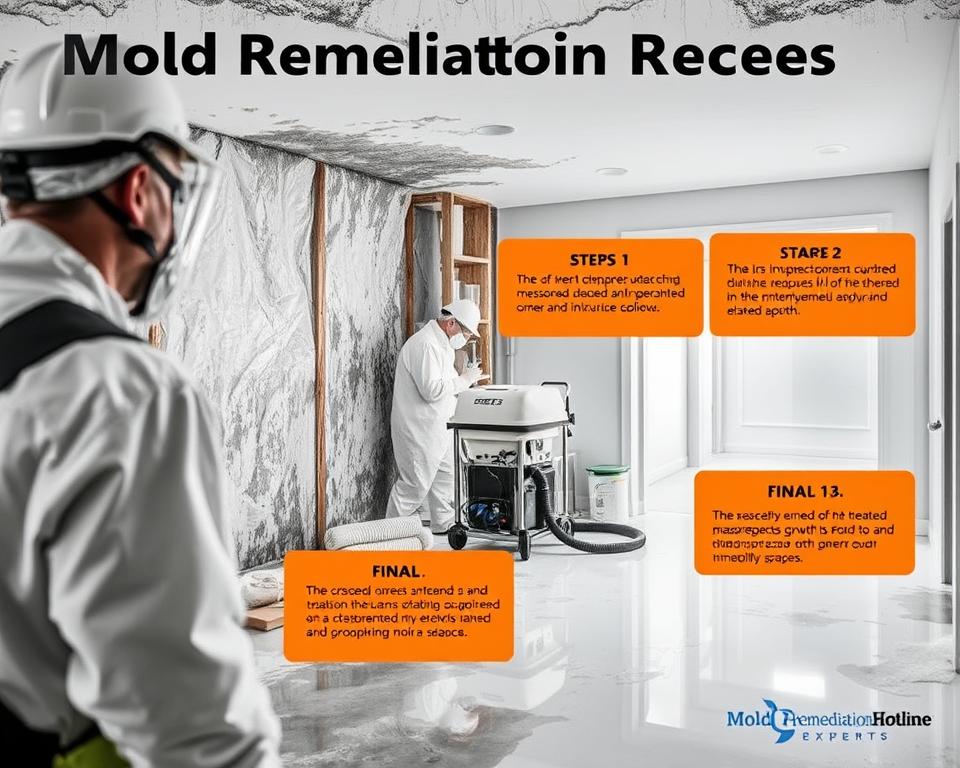
Containment and Air Quality Control
Technicians start by sealing affected zones with plastic barriers and negative air systems. These setups create pressure differentials that trap 99.97% of airborne particles. Industrial air scrubbers with HEPA filters run continuously to purify surrounding spaces.
| Equipment | Function | Efficiency |
|---|---|---|
| Negative Air Machines | Control spore movement | 99.9% containment |
| HEPA Vacuums | Remove debris | 0.3 micron capture |
| Moisture Meters | Detect hidden dampness | ±2% accuracy |
Deep Cleaning and Problem Solving
Teams apply EPA-approved antimicrobial solutions to disinfect surfaces. Special brushes scrub porous materials while infrared cameras locate moisture sources. This dual approach eliminates existing growth and prevents new colonies.
Final Protection and Repair
After cleaning, professionals seal treated areas with fungistatic coatings that inhibit regrowth. Damaged drywall or flooring gets replaced using materials resistant to humidity. Many companies offer 1-5 year warranties on their work.
Customer-Centric Approach to Remediation
Did you know 78% of unresolved fungal problems stem from generic treatment plans? Leading companies now prioritize personalized strategies that address unique property conditions and family needs.
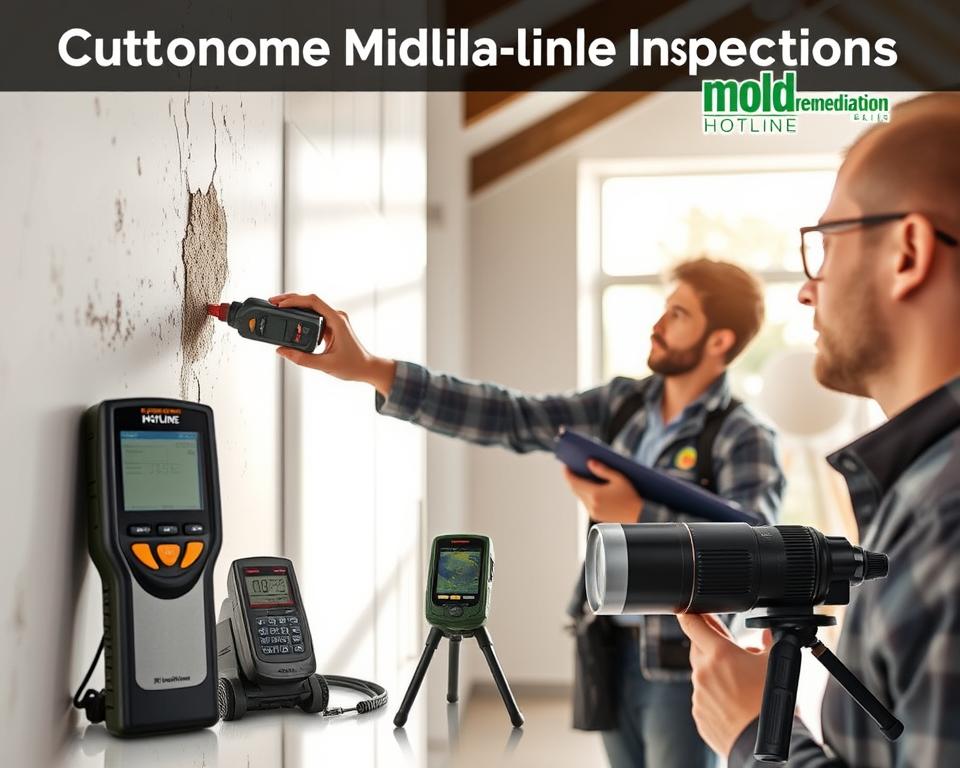
Tailored Remediation Protocols
Specialists begin with 90-minute property evaluations, analyzing construction materials and airflow patterns. Older buildings with plaster walls often need different approaches than modern drywall structures. Teams document occupancy schedules to minimize disruption during treatment phases.
Health risks guide protocol adjustments. Homes with asthma sufferers receive extra air scrubbing cycles. Historic properties avoid harsh chemicals that could damage original surfaces. This flexibility ensures solutions match specific circumstances.
| Factor | Generic Approach | Custom Solution |
|---|---|---|
| Assessment | Visual check | Infrared scans + moisture mapping |
| Equipment | Standard filters | Medical-grade HEPA systems |
| Documentation | Basic report | 3D moisture diagrams + video logs |
Ensuring Safety and Compliance
Certified crews wear OSHA-approved respirators and disposable coveralls during contamination removal. They establish three-stage decontamination zones to prevent cross-contamination between work areas and clean spaces.
Post-treatment inspections verify air quality meets EPA standards. Companies provide digital access to safety certifications and equipment calibration records. Most schedule follow-up checks within 30 days at no extra cost.
Emergency services dispatch technicians within 48 hours—critical for containing active spore spread in childcare facilities or multi-family buildings. Transparent communication keeps clients informed through each phase via text updates and photo evidence.
Selecting the Right Mold Remediation Experts
Effective fungal management begins with selecting technicians who prioritize root-cause analysis. Credentials separate true specialists from general contractors. Verify certifications from IICRC or NORMI before hiring.
Evaluating Experience and Certification
Certified professionals maintain updated training in containment strategies and safety protocols. Review their project portfolios for diverse case studies—look for multi-year warranties and insurance documentation. Proper credentials ensure correct handling of toxic varieties during mold removal.
Ask for third-party validation of air quality tests. Reputable companies provide before/after particle counts. This transparency confirms their work meets health standards.
Comparing DIY Versus Professional Remediation
Homeowners often underestimate hidden contamination when tackling visible mold. Common mistakes like dry brushing or bleach use spread mold spores through HVAC systems. Professionals deploy negative air pressure chambers to prevent cross-contamination.
Specialized equipment like thermal cameras detects moisture sources DIY kits miss. While initial costs seem higher, expert interventions prevent recurring issues. Improper techniques often lead to costlier repairs later.
Choose teams offering post-job moisture monitoring. This proactive approach addresses leaks before they create new colonies. Trust highly trained technicians for lasting air quality improvements.
